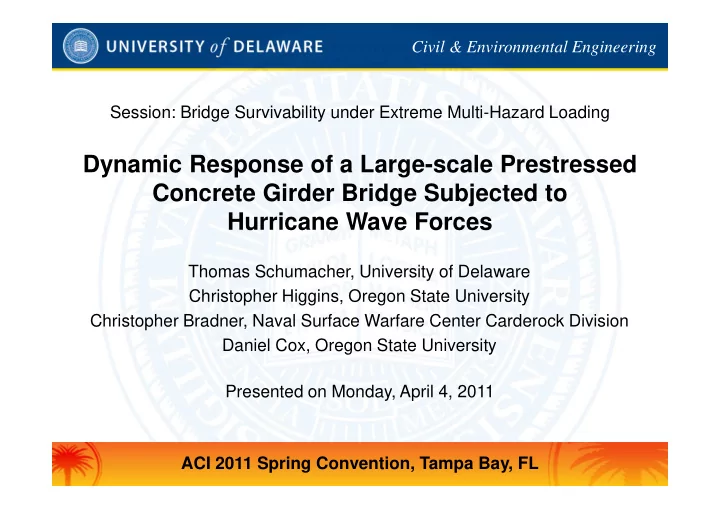

Civil & Environmental Engineering Session: Bridge Survivability under Extreme Multi-Hazard Loading Dynamic Response of a Large-scale Prestressed Concrete Girder Bridge Subjected to Hurricane Wave Forces Thomas Schumacher, University of Delaware Christopher Higgins, Oregon State University Christopher Bradner, Naval Surface Warfare Center Carderock Division Daniel Cox, Oregon State University Presented on Monday, April 4, 2011 ACI 2011 Spring Convention, Tampa Bay, FL
Overview FL MS AL LA US 90, Biloxi Bay I-10, Escambia Bay I-10, Mobile Bay US 90, Bay St. Louis Bridges damaged during I-10, Lake Pontchartrain hurricanes in 2004 and 2005 Source: Douglass, University of South Alabama / Google Maps
I-10 Bridge over Escambia Bay, FL Source: Pensacola News Journal
US 90, Biloxi Bay Bridge, MS Source: Douglass, University of South Alabama
Background • Project task: Determine forces on bridge superstructures due to hurricane waves, develop methods to estimate forces • Large-scale test, 1:5 • Bridge model with realistic details and properties • Tunable lateral support system (rigid, dynamic, unrestrained) • Direct measurement of reaction forces Photo courtesy S. Yim, OSU • Interdisciplinary research team from Coastal & Structural Engineering
Why testing? • Past research: Off-shore structures � not valid for coastal bridges! - - Equations to estimate forces for piles, vertical walls, flat slabs - Small-scale experiments, scale of 1:50 to 1:8 - Integration of local pressure measurements to get overall forces - Realistic structural behavior neglected (no substructure flexibility) • 2008 AASHTO guidelines need verification: - equations based on rigid substructure configuration - no guidance on how overall forces are distributed to girders
How to model realistic bridge behavior SWL Cross section of typical bridge
6 AASHTO Type III girders, 4 diaphragms
Span length = 11.3 ft (56.7 ft)
Total weight = 4034 lbs (504 kips)
Assembled test setup
Tunable lateral support system Phase 1: quasi rigid Phase 2a: medium springs Phase 2b: soft springs
Elevation view test setup Accelerometers Displacement sensors Horizontal load cells Vertical load cells
O.H. Hinsdale Wave Research Laboratory
Overview of Experiment Regular and random waves ( T = 2.0 to 4.5 s) • Hurricane Katrina conditions ( H = 1 to 3 ft) • Water height (SWL) • Structural parameters • - 3 substructure flexibilities - With/without guard rail - Unconstrained Data set of ~400 test trials •
Experimental Data All data for d c = 0 (water level even with bottom line of girders) • • Pressure vs. force measurements • Maximum reaction forces • Horizontal reaction forces: rigid vs. dynamic substructure • Reaction forces vs. wave height (correlation plot) • Rigid vs. dynamic response • Comparison with 2008 AASHTO guidelines • Show time!
Pressure vs. force measurement
Maximum reaction forces 5 25 Weight of bridge span 4 20 Horizontal Force (kN) Vertical Force (kN) 3 15 2 10 1 5 H = 0.6 m, T = 3.0 s Horizontal Force, F h Vertical Force, F v 0 0 -1 -0.5 0 0.5 1 d *
Horizontal reaction forces: rigid vs. dynamic setup Horizontal force (rigid) Horizontal force (dynamic)
Reaction forces vs. wave height (correlation plot) Incident wave height, H in [ft] Incident wave height, H in [ft] 0.0 0.3 0.6 0.9 1.2 1.5 1.8 2.1 2.4 2.7 3.0 0 0.3 0.6 0.9 1.2 1.5 1.8 2.1 2.4 2.7 3 12000 Regular waves, T = 2.5 s Regular waves, T = 2.5 s 36000 8000 10000 2250 Rigid setup Rigid setup 30000 6500 Flexible setup Flexible setup Horizontal force, F h [N] Horizontal force, F h [lb] 8000 1750 Vertical force, F v [N] Vertical force, F v [lb] 24000 5000 6000 1250 18000 3500 4000 12000 750 2000 2000 6000 250 500 0 0 -250 -1000 -2000 -6000 -750 -2500 -4000 -12000 0.0 0.1 0.2 0.3 0.4 0.5 0.6 0.7 0.8 0.9 1.0 0 0.1 0.2 0.3 0.4 0.5 0.6 0.7 0.8 0.9 1 Incident wave height, H in [m] Incident wave height, H in [m] Horizontal reaction forces Vertical reaction forces
Comparison with 2008 AASHTO Guidelines
Comparison with 2008 AASHTO Guidelines
Movie 1: Phase 1 (rigid setup)
Movie 2: Phase 2b (soft springs)
Movie 3: Phase 3 (unconstrained)
Ongoing and Future Work • 2008 AASHTO guidelines: - Verification of predictions Guidance on trapped air factor TAF - - Extension of equations for flexible substructures • Research on Tsunami loading of bridges
Civil & Environmental Engineering Thank you for your attention!
Publications • Schumacher, T., Bradner, C.; Higgins, C.; Cox, D.; Wave Forces on Bridge Superstructures: Large-Scale Laboratory Observations and Comparison with AASHTO Guidelines; in preparation . • Bradner, C., Schumacher, T., Cox, D., Higgins, C.; Experimental Setup for a Large-Scale Bridge Superstructure Model Subjected to Waves. ASCE Journal of Waterway, Port, Coastal, and Ocean Engineering , Vol. 137(1), January/February 2011, pp. 3–11. • Schumacher, T.; Higgins, C.; Bradner, C.; Cox, D.; Yim, S.; Large-Scale Wave Flume Experiments on Highway Bridge Superstructures Exposed to Hurricane Wave Forces; Proceedings of the Sixth National Seismic Conference on Bridges and Highways (6NSC) ; Charleston, SC; July 27– 30, 2008.
Recommend
More recommend